How to Grow AMAZING Sweet Peas in Containers
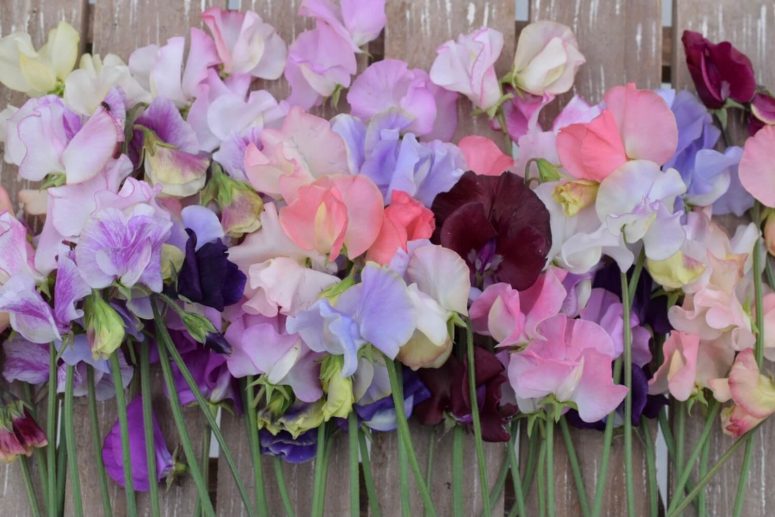
I started growing sweet peas in containers out of necessity. I had an incredible desire to experience in my own garden these gorgeous fragrant flowers I was seeing all over Instagram. But I don’t own land. I’ve been renting for 10 years and have moved four times within that time period (once I had to move my baby sweet peas with me!) So container growing was, and still is, the only option for me. After five successful years growing sweet peas in containers I am ready to share my secrets! I can tell you that they grow amazingly well and you will be astounded at the amount of blooms your plants will produce!
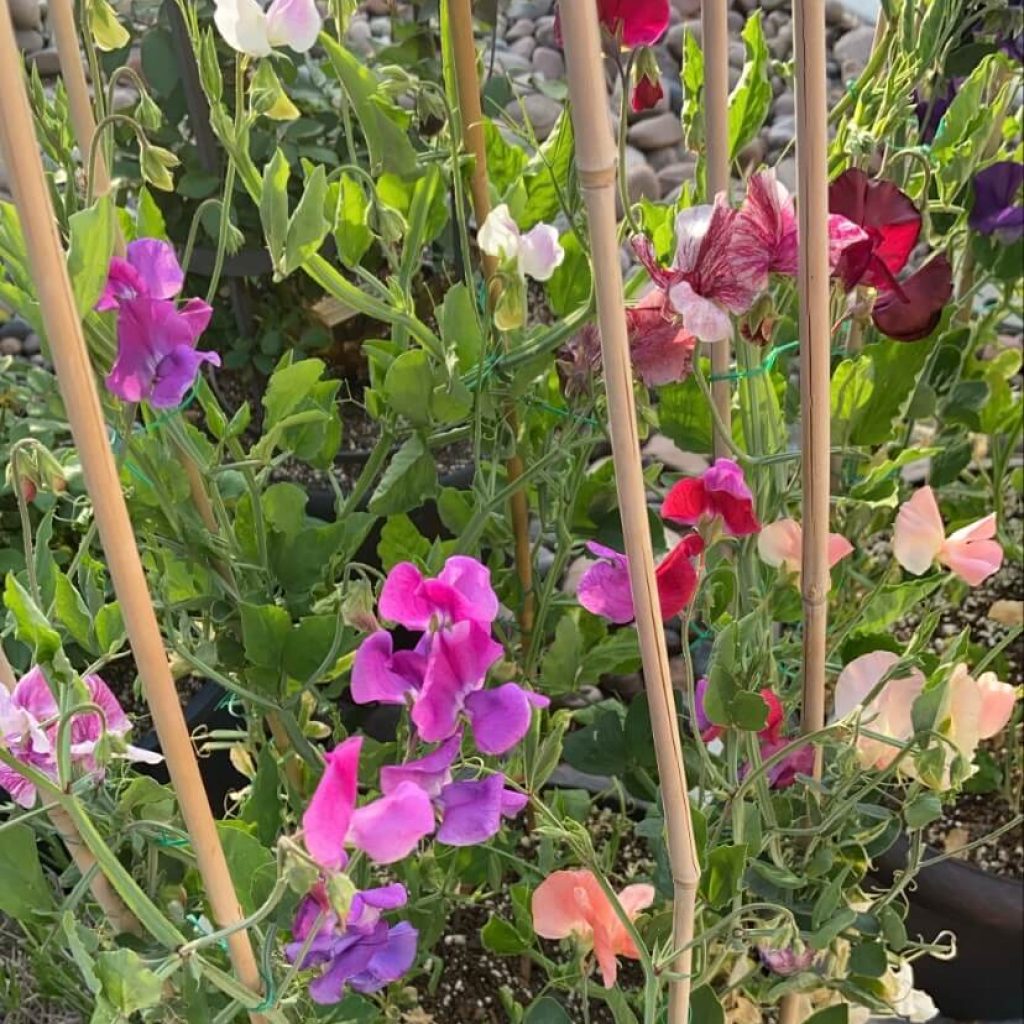
Disclaimer: when you shop through my affiliate links I earn a small commission which helps me create more content, at no additional cost to you! Thank you so much for your support!
To get your sweet peas seeds started please visit my article HERE. Today’s post is all about what to do with your sweet pea seedlings after they have already been growing in their seedling pots and have developed a good root system (hopefully you planted them in autumn as I recommend in THIS POST). If you have been growing them indoors be sure to harden them off (get them used to sun and wind) slowly over the course of a week prior to planting them in their final homes. Note: sweet peas, Lathyrus odoratus, are NOT edible and are toxic if consumed.
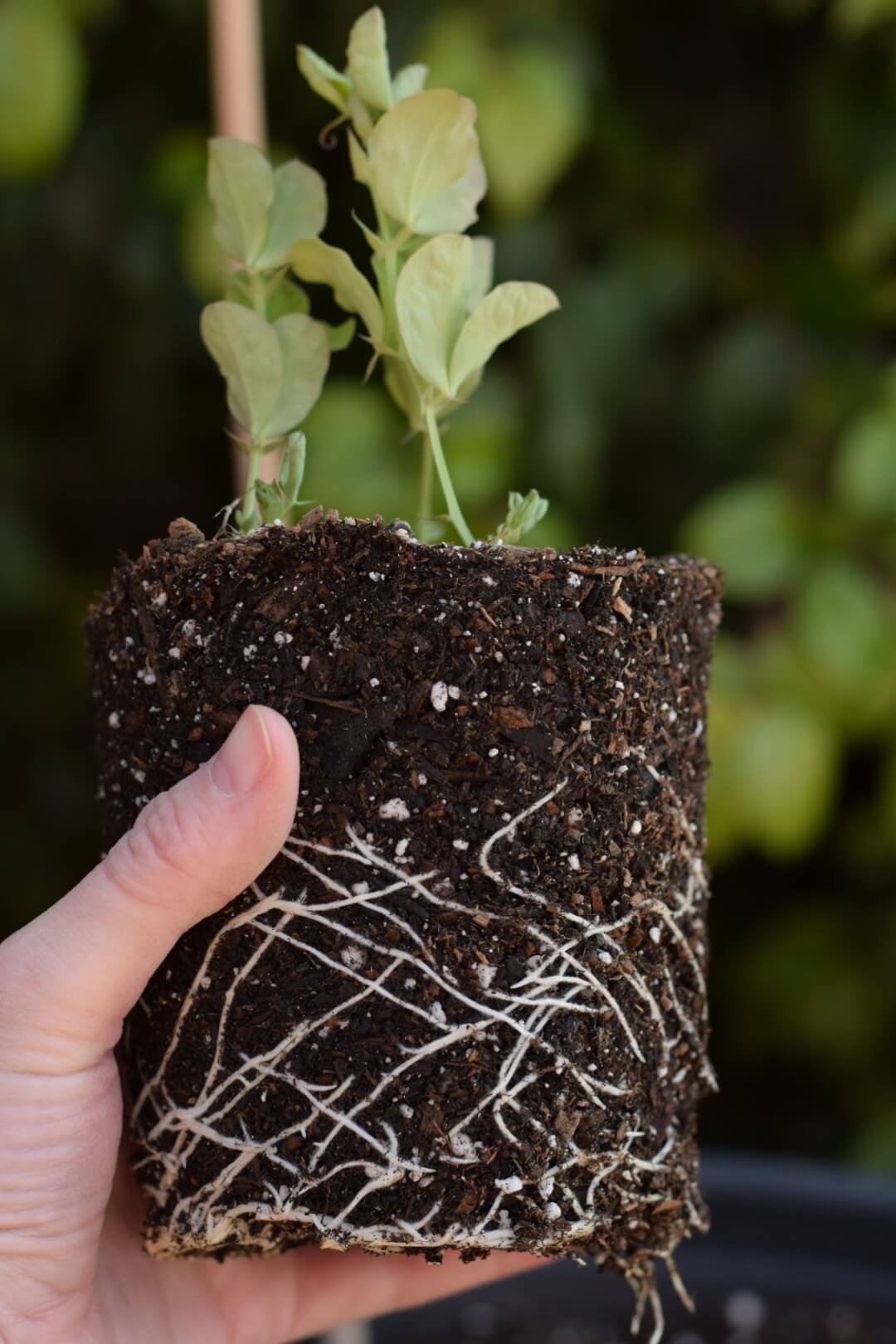
Big Containers are Best
Choose your container wisely. Buy as large a container as possible, and preferably made of plastic if you live in an arid climate like I do. My containers are plastic, 20 inches wide by 16 inches deep, and hold 1.5 cubic feet of potting mix. This allows the plants to root deeply, provides some insulation from the heat, and makes it easier to maintain an even moisture level. If you choose a smaller pot you will need to use fewer plants and be aware that the vines may get top heavy and topple on a windy day. Stay away from terracotta pots if you live in a hot arid climate as they will dry out very quickly and your goal is to keep the roots as cool and moist as possible. It is possible that if you live in an overly wet climate that terra cotta could work for you- please experiment or use what you know works in your environment!
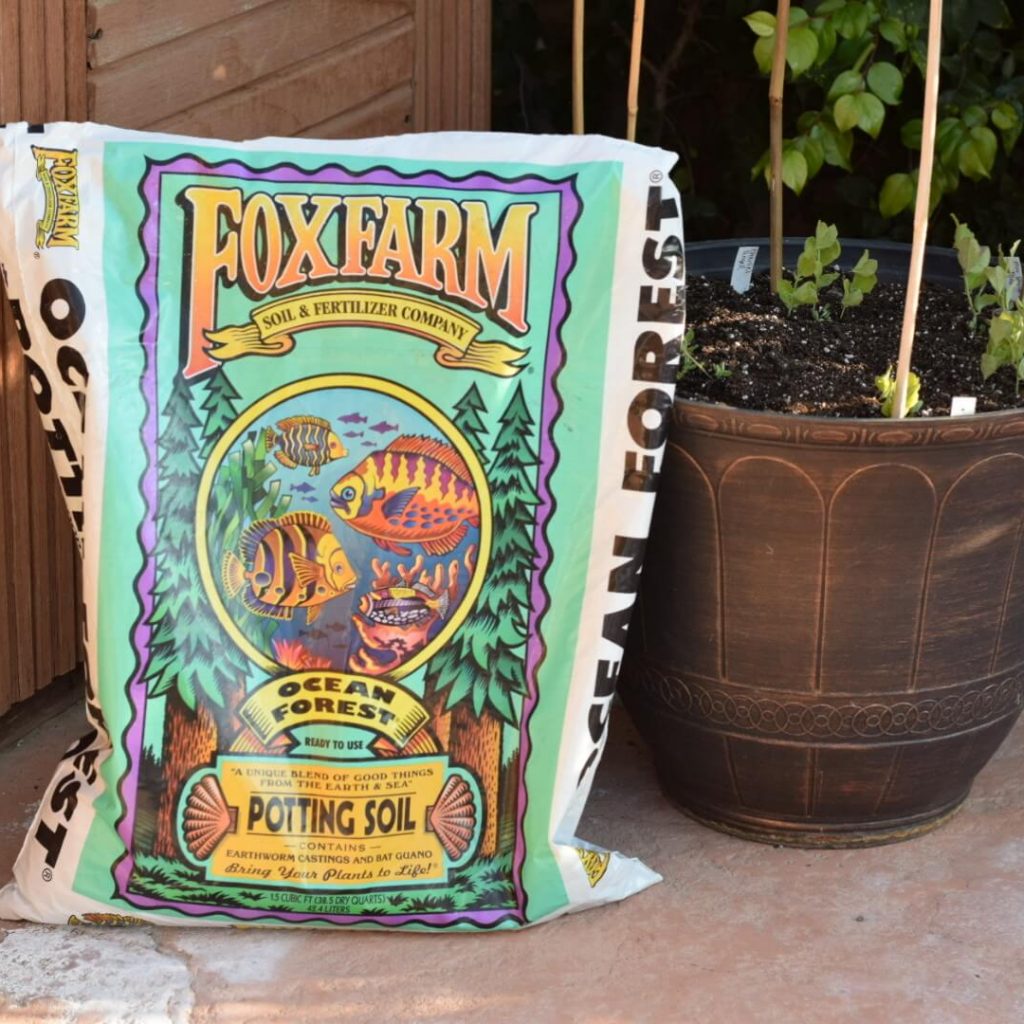
Buy the Best Potting Mix
Do not use soil dug up from your garden. It performs strangely in a pot and can compact and have other issues. Use a high quality “potting mix”- the best you can afford. I have always used FoxFarm Ocean Forest. It is free draining and has plenty of nutrients.
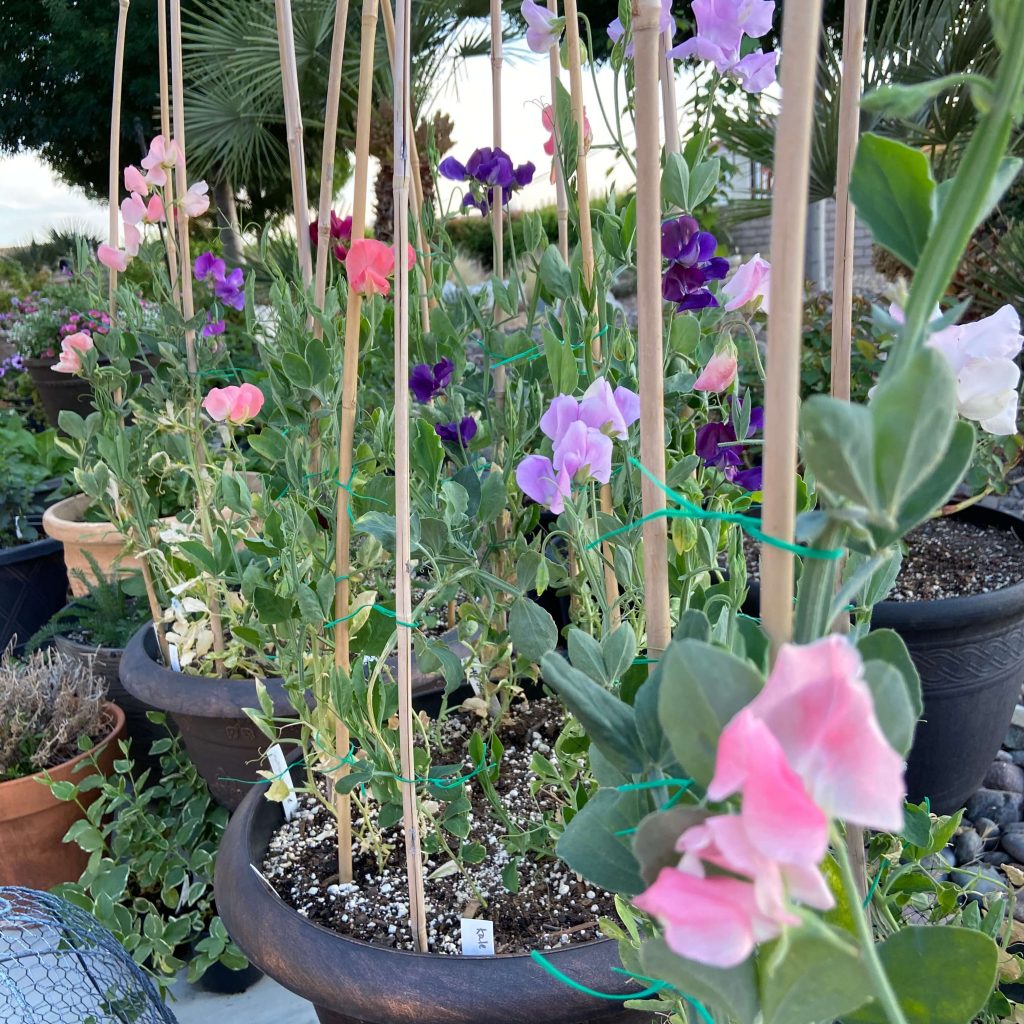
Support the Vines
Your sweet pea vines need something sturdy to climb on. I have found that the best and most attractive supports are 6 ft. bamboo canes. They are inexpensive and last a long time. Sink six in a pot until you hit the bottom and wire or tie them together at the top forming a teepee shape. Make sure the top is secure as you do not want the canes springing apart and ripping your vines. As the vines grow, tie them up the cane using garden ties. I have always used a twist tie with cutter because it is easy and quick to cut a piece and twist it onto the cane and plant leaving a small amount of space between the two. Once your plants really get growing, this will become a weekly “chore” (I find it quite relaxing). Don’t neglect your vines and let them flop around in the wind.
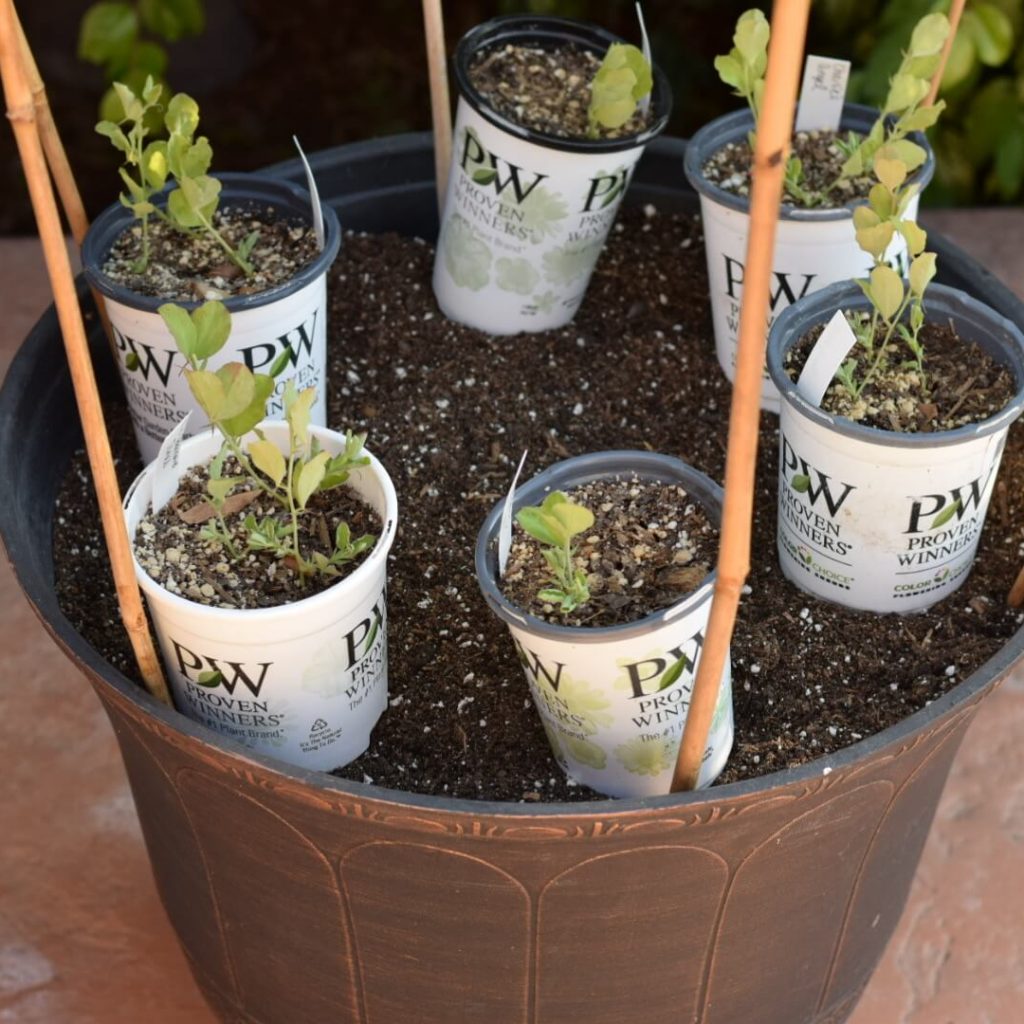
Plant the Seedlings
In zone 8b I plant my seedlings into their big pot homes in February or March depending on the weather. You don’t want to wait too long, but you also don’t want to plant them too early when temperatures are still dipping into the 20’s or teens. They don’t mind frost, but if a brutally cold day happens it is much easier to move the seedling pots into the house or garage for protection than to move the large pots.
I plant my pots a bit on the heavy side because of lack of space, but they always do great regardless. Plant six seedling pots evenly spaced and in front of a bamboo cane in the large pots (which totals about 12 plants because there are usually actually 2 plants in each of my seedling pots). I don’t recommend planting seeds directly into the big pots. If your climate is too wet the seeds could rot. Instead, start them off in quart sized pots in fall (warm climates) or late winter/early spring (cool climates) and then when they have established root systems move them into the big pots. My paper towel/baggie method is a good way to sprout them if you have been struggling or have older seeds.
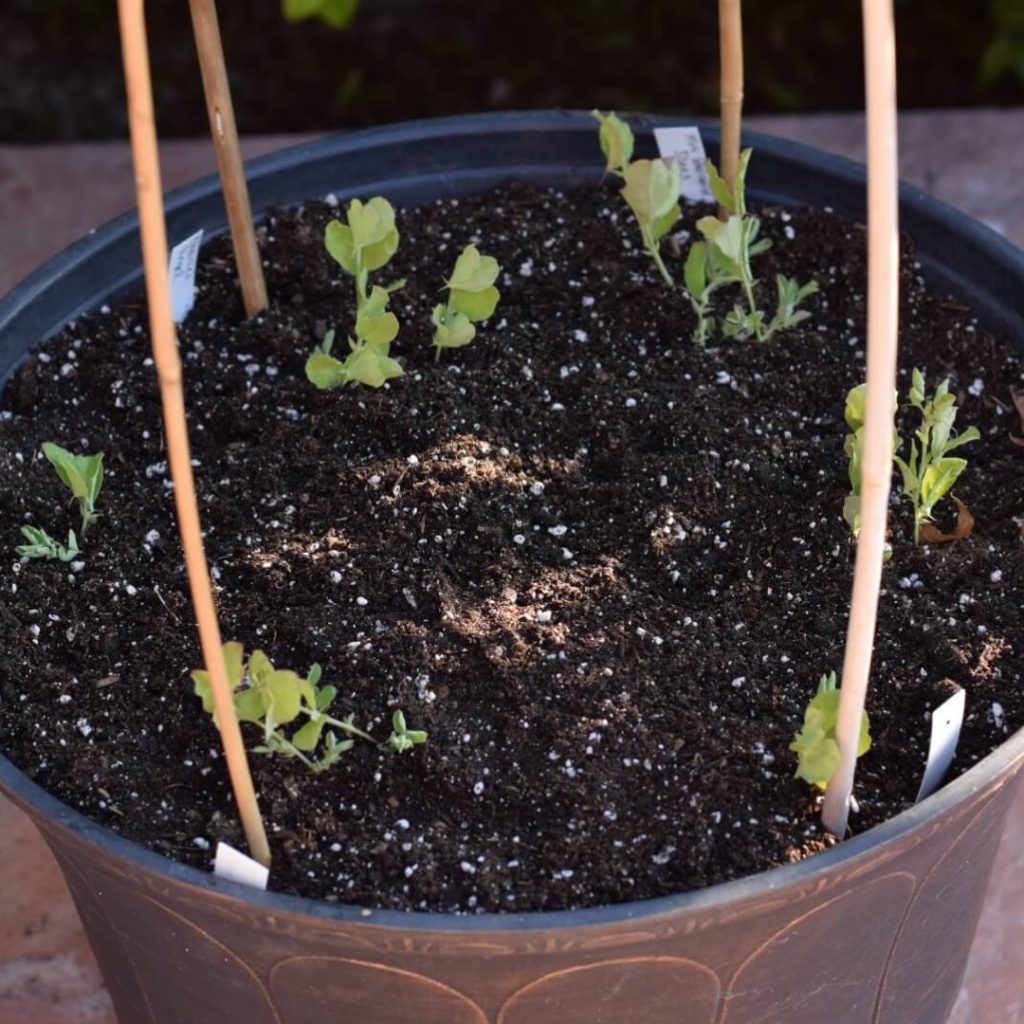
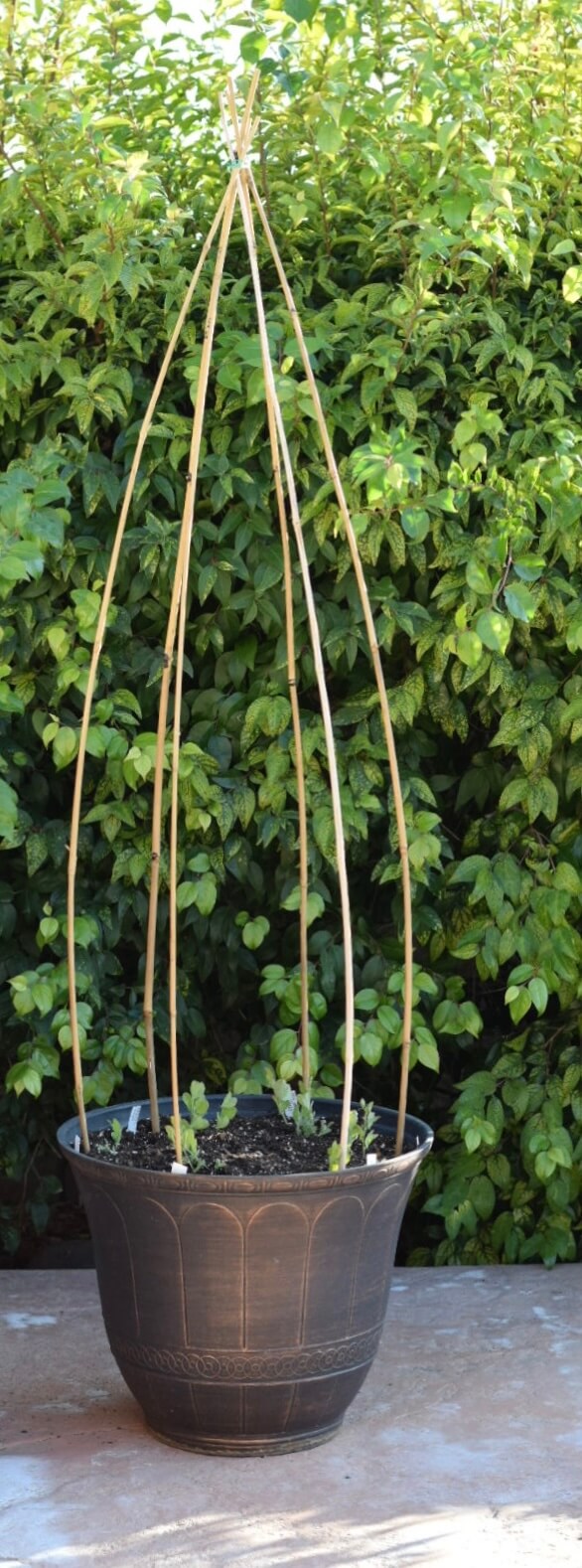
Sweet Peas Need Sun
As long as the weather remains cool, sweet peas love being in full sun. You will get the quickest growth and flowering if they are in full sun. Once the heat begins to arrive (in late May and early June for me) the plants will last a bit longer if protected from the hot afternoon sun. At the very least protect the roots by positioning them so the vines are in sun and the roots are in shade (some potted plants clustered around the sweet pea containers helps with this!) It also helps if you can protect the plants from the wind.
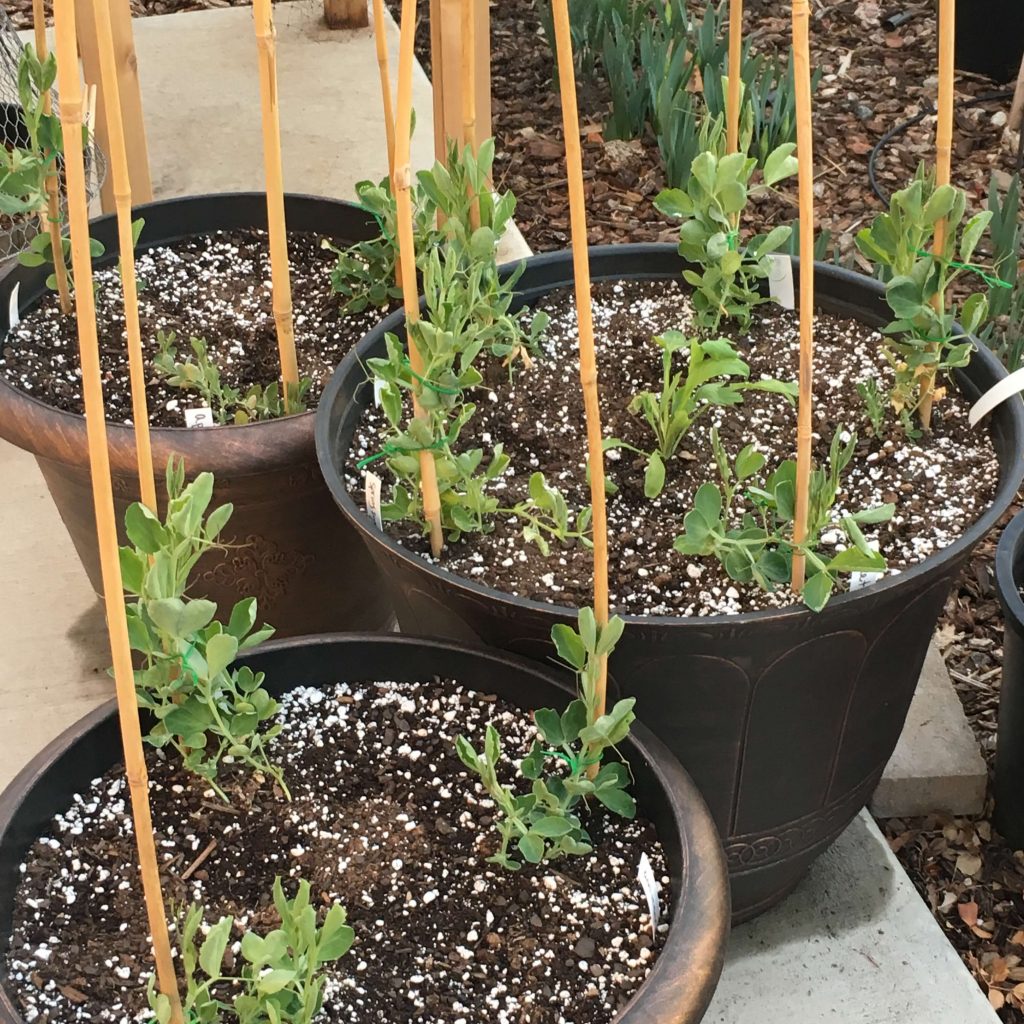
Water and Fertilize
Never let your sweet pea containers completely dry out. Using large pots will make this easier. Conversely, you don’t want to overwater them either so always check your soil with your finger before watering. Don’t water if the soil feels moist an inch or two below the surface. Water if it feels dry. I don’t use a lot of fertilizer because the potting soil I use has plenty. I will sometimes provide a trowel or two of compost or a watering in of fish emulsion. If the foliage looks pale definitely provide some fish emulsion.
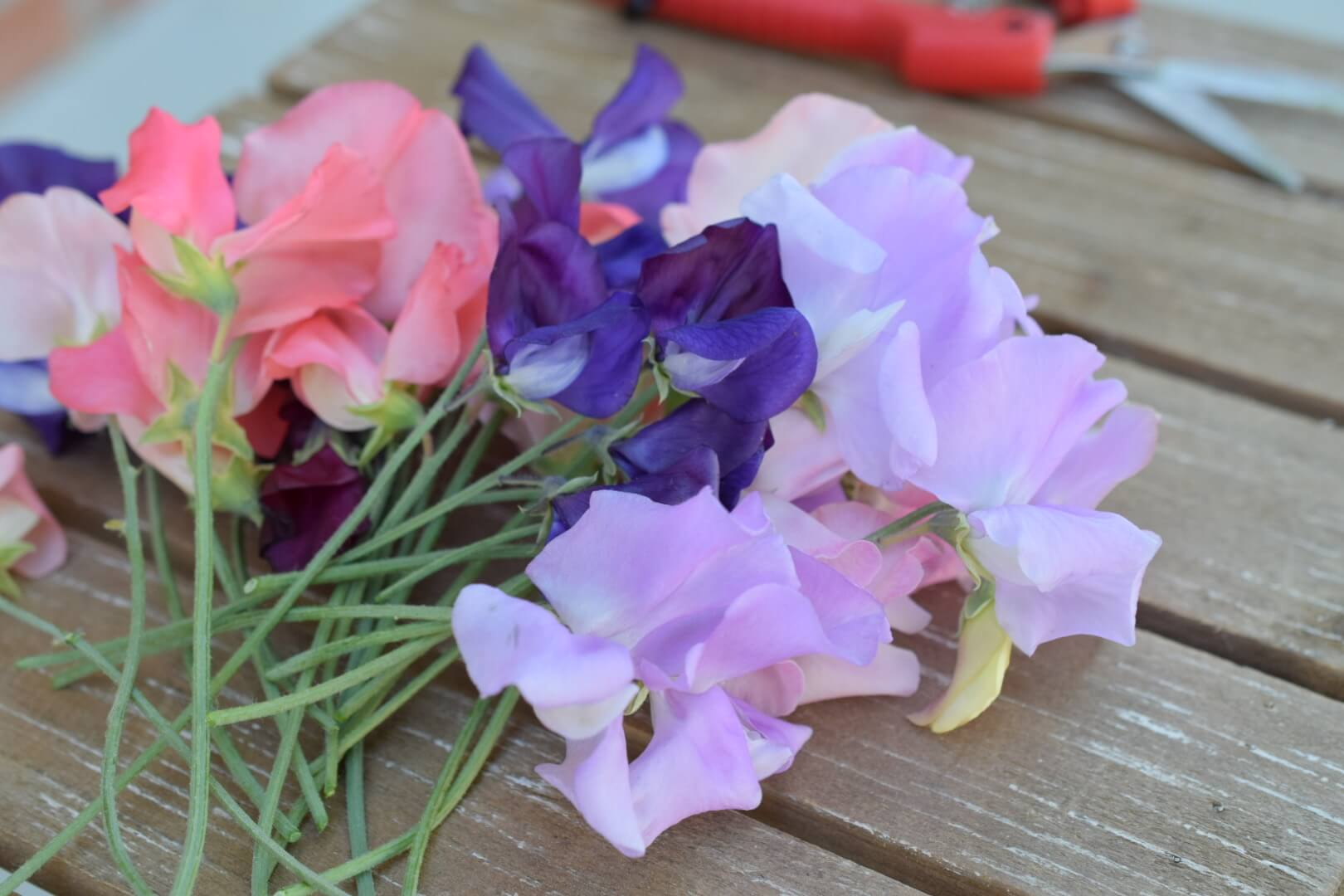
Cut the Blooms and the Tendrils!
The more you harvest your sweet peas the more they will bloom for you. Never let them go to seed as that sends a message to the plant to stop producing flowers. It can almost become a chore keeping up with all of the flowers, but I think it is a great chore to have! You can pick them when all the flowers on a stem are open, or when the top flower buds are just starting to show color for longer vase life. You will notice many tendrils on your vines as well. Since I tie my sweet peas to the bamboo canes, the tendrils serve no purpose and just make a mess wrapping themselves around neighboring vines and flowers and take energy from the plant. I cut them off every time I harvest the flowers. Make sure you do not cut the growing tip of the vine.
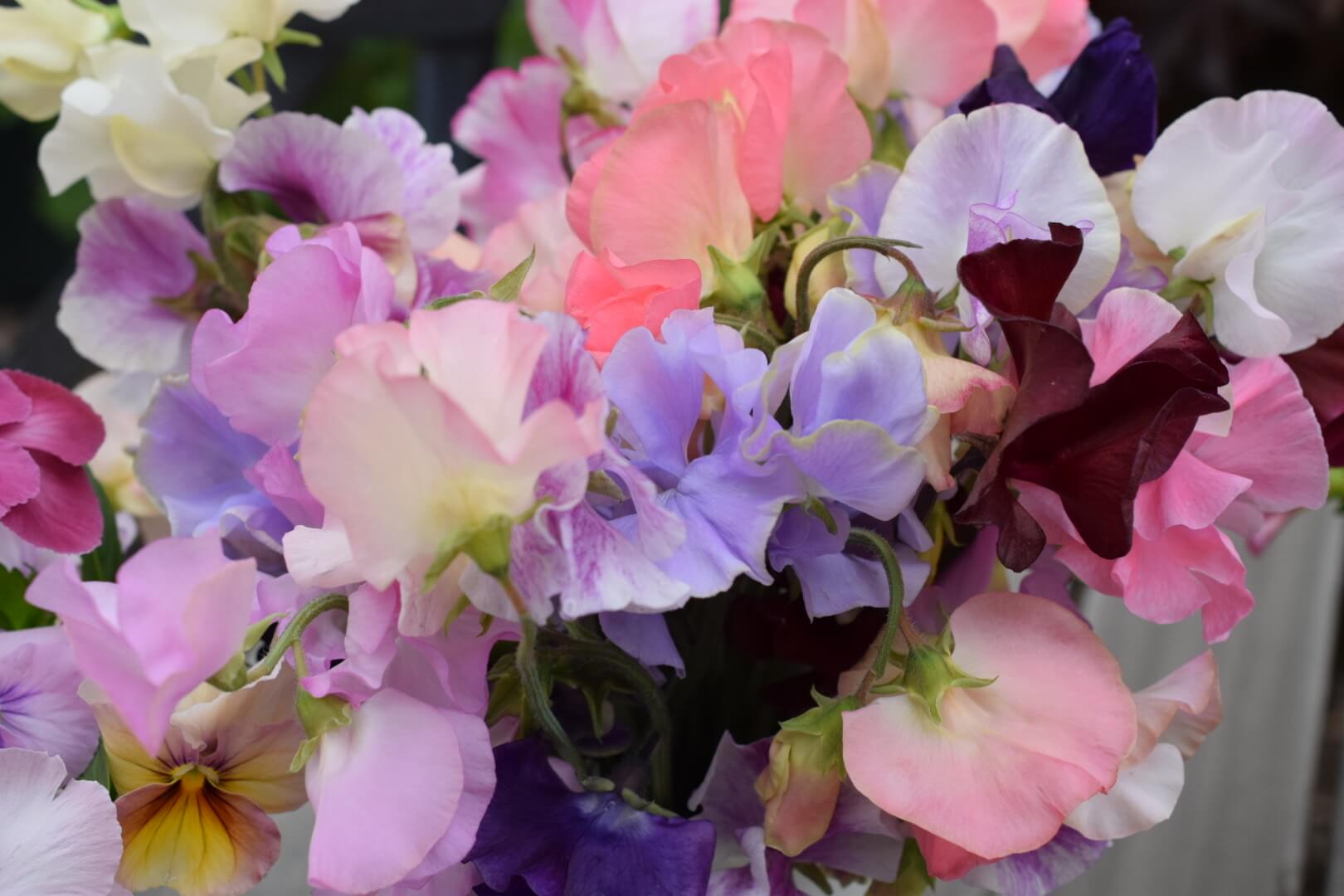
Pests and Diseases
As an update for 2023, birds have attacked my sweet pea seedlings! It remains to be seen if I will get any blooms this year because the damage was so extensive. If birds are a problem in your area I now recommend netting your seedlings after you plant them in the large pots until they have put on some considerable growth.
My plants are usually not bothered by pests and diseases until the hot weather arrives and begins to stress them out. At that point I will often see powdery mildew and thrips appear on the older foliage. Often this will coincide with bloom production slowing down- sweet peas really do not like the heat! If you want to try to control these issues you can try sticky traps and sprays, but in reality once temperatures are consistently in the high 90’s the sweet peas days are numbered and the vines will begin to die back and they will stop blooming.
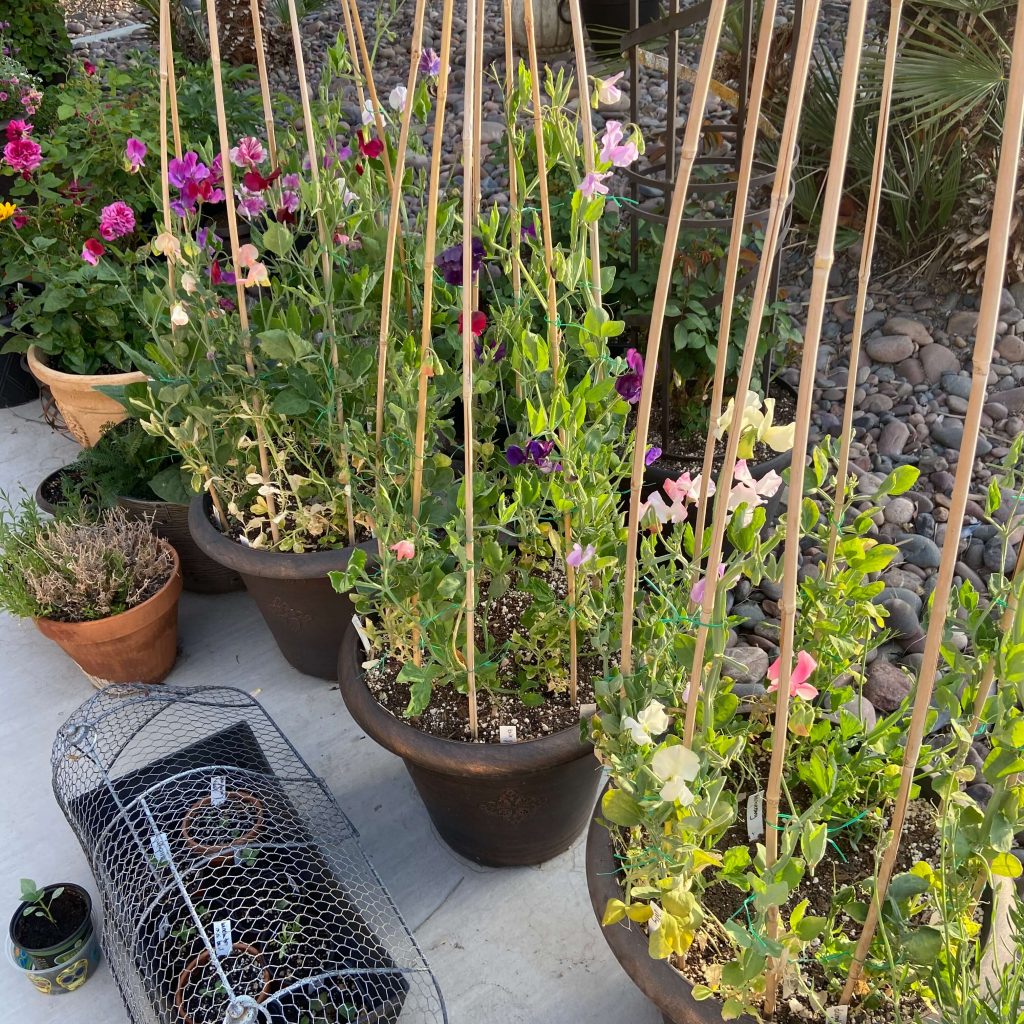
I feel like I could go on and on about growing sweet peas in containers! I hope that this post gives you a starting point for growing these gorgeous fragrant flowers. As always, keep in mind that things may need to be tweaked to accommodate your individual climate and growing conditions. I would love to read your comments and questions either down below or on my Instagram!
Happy Gardening,
Heather
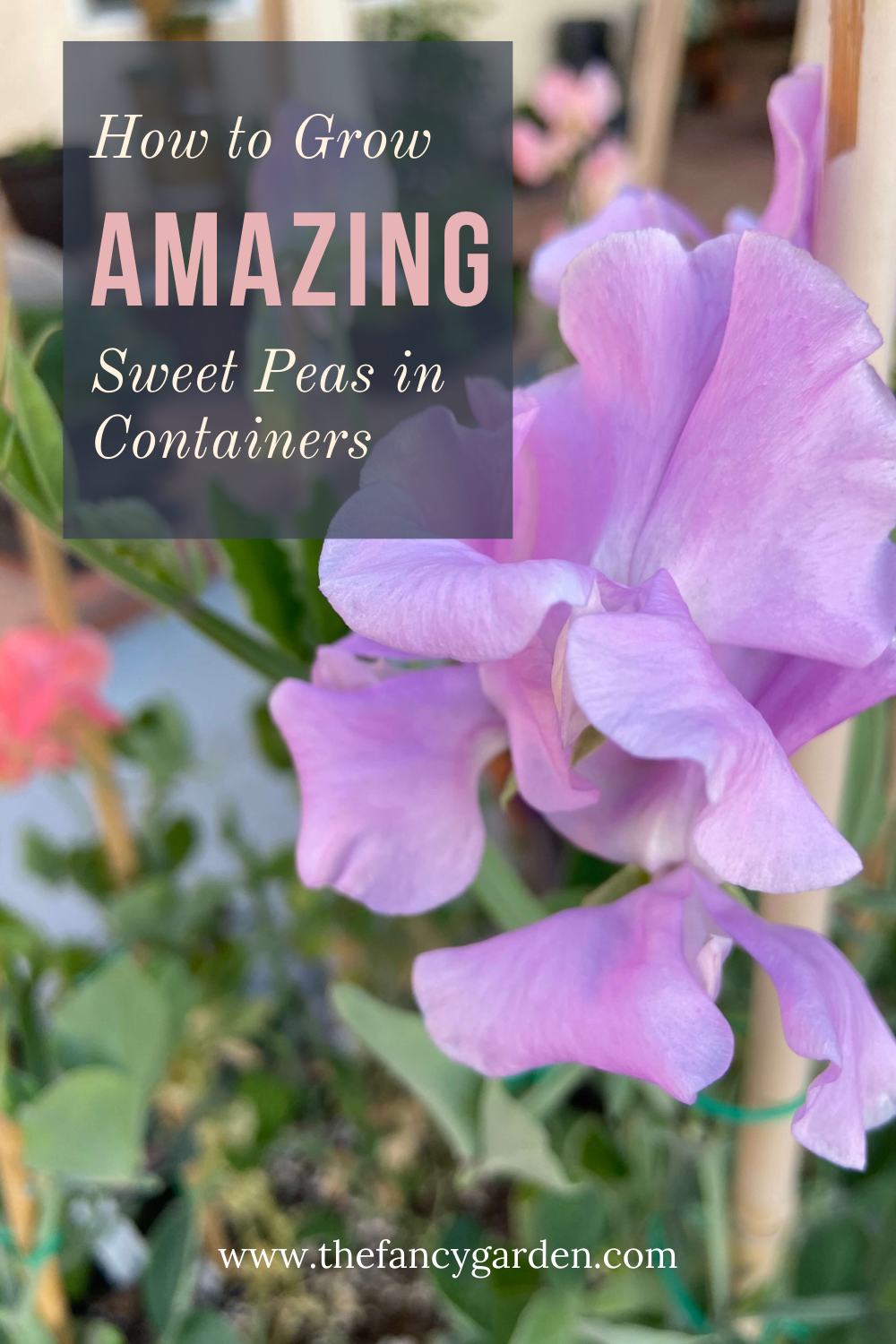
Related Posts
How to Easily Grow Beautiful Zonal Geraniums from Seed
When I discovered how easy it is to grow beautiful zonal geraniums (Pelargonium hybrids) from…
08/01/2023How to be Successful Growing Anemones in Pots
Anemones (Anemone coronaria) are one of my favorite flowers to grow in pots for a…
12/06/2022



Nora Mylett | 28th May 21
This spring is my first try at Sweet peas, and they’ll be in three large pots next to a trellis that is firmly attached firmly to the exterior wall of my house. My question and concern is about animals munching/devouring them. We have chipmunks squirrels rabbits and deer. I recently discovered coyote urine that keeps the deer away, but what about the others, are sweet peas at risk?
Heather | 29th May 21
Hi Nora, I do not have any of those critters that you deal with so I am not sure if your sweet peas will be eaten or not. You may just want to cover them as best you can with chicken wire and/or bird net and research repellents. Best of luck to you!
TERRY | 20th Apr 22
Why do you not recommend planting sprouted seeds directly in big containers? PS: love your posts!
Heather | 21st Apr 22
Hi Terry! I’m so happy you love the posts! For new gardeners it can be difficult to maintain the moisture level in a large pot. If it is overwatered the tiny seed can quickly rot, especially if you are planting in fall when the pot of soil will be cold and damp all winter. If you are more experienced you can certainly give it a try to plant them directly- this will likely be more successful with a spring planting and don’t forget to provide some protection from the birds!
richard long | 30th Oct 22
hello
great post thank you
i have a wedding july 8 2023 and want to have a few pots of sweet-peas flowering by then
i am in the gulf islands …zone 9a or 9b…they are very close between mayne island and saturna
i’m on mayne
could you please advise me on the best way to accomplish this
start the seeds in small containers late fall? (how moist to keep them?)
start them early spring?march?
it would be lovely to have a gorgeous stand of fragrant sweet-peas for the outdoor ceremony july 8
i will have them in large 10gal pots with a wire trellis around the perimeter so they stand as a tall accent where the bride will walk
thank you so much
cheers rick
Heather | 30th Oct 22
Hi Richard,
It will all depend on your temperature as to whether this would be successful or not. Sweet peas HATE the heat. If your daily temperatures stay below 80F then you will be fine, otherwise they will likely die off. If you are lucky enough to live in a cool climate then you could try both a fall and a spring planting to hopefully ensure success. Check out my blog post on autumn planting sweet peas for more info on fall planting. Best of luck!
Maya | 29th Aug 23
I really enjoyed reading your article with so much information!
Sorry if I missed it but do you plant dwarf or knee-high varieties that don’t get too tall? Or do you plant varieties that can grow more than 6ft in a container?
Also, do you pinch your sweet peas to make them bushier and to stop them getting taller than your support teepee? What do you do if it reaches the top of the teepee?
Sorry for asking so many questions but I deeply appreciate if you can share your thought.
Heather | 6th Sep 23
Hi Maya! I tried the knee-high variety once and didn’t have much luck. I currently just grow the full size varieties. Some years I pinch them, some years I do not. I have found that when you plant them in autumn, there is no need to pinch. The sweet peas usually always grow taller than the supports. When they do I just wind them back down towards the bottom. Hope this helps! Thanks!
Eleanor | 6th Jun 25
Hi Heather. I have planted my sweet pea seeds directly in a pot and they have grown so well. I have a wire trellis over the pot and they are rushing up to the top! They were planted in March but have not flowered yet. I live in Augusta GA so we get lots of sun and heat. Should I move the pot onto my screened porch or leave outside. They get sun mostly in the mid to late afternoon and are in shade the majority of the day. I check their moisture daily and we have also had a lot of rain this year. I can’t wait for blooms. Thanks for your info too. I enjoyed reading it.
Eleanor